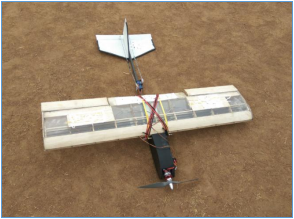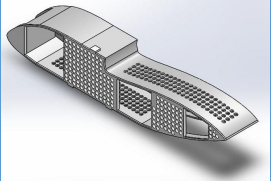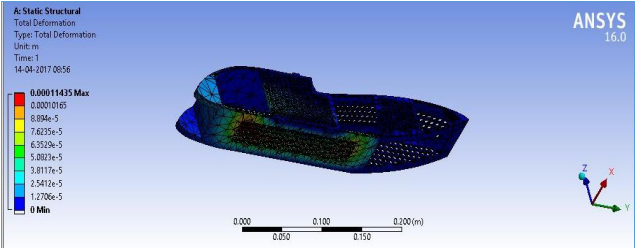Examining the Effectiveness of 3D Printing for Drone Construction (MALE UAVs)
 Drones are becoming more and more a part of modern life, being used for everything from military applications to delivering pizza, not to mention the growing number of hobbyists using them personally. Drones have come of age, so to speak, alongside 3D printing, and therefore 3D printing is commonly used to construct drones, also known as unmanned aerial vehicles or UAVs. In a paper entitled “Implementation of FDM technology in MALE UAVs,” a group of researchers discuss the advantages of using 3D printing for drone manufacture.
Drones are becoming more and more a part of modern life, being used for everything from military applications to delivering pizza, not to mention the growing number of hobbyists using them personally. Drones have come of age, so to speak, alongside 3D printing, and therefore 3D printing is commonly used to construct drones, also known as unmanned aerial vehicles or UAVs. In a paper entitled “Implementation of FDM technology in MALE UAVs,” a group of researchers discuss the advantages of using 3D printing for drone manufacture.
MALE stands for Medium Altitude Long Endurance. According to the researchers, there are numerous advantages of using 3D printing over other methods of fabrication. Using PLA makes UAVs more eco-friendly, for one thing, and also improves their strength to weight ratio. 3D printing allows designers to densify certain areas, such as the landing gear or nose tip, that will experience greater impact, while compensating by reducing weight elsewhere. The technology also makes it easier to create an aerodynamic design, and saves time, money and effort compared to other manufacturing methods.
 In the study, the researchers developed a 3D printed drone fuselage, which is described as the “backbone” of the drone. It serves as a housing for payload as well as many other components, so there are several weight, aerodynamic and structural constraints that have to be considered in its design. The length of the fuselage also affects the stability of the drone, and it is important to streamline the body so that air can flow around it in such a way as to keep the drag effects low.
In the study, the researchers developed a 3D printed drone fuselage, which is described as the “backbone” of the drone. It serves as a housing for payload as well as many other components, so there are several weight, aerodynamic and structural constraints that have to be considered in its design. The length of the fuselage also affects the stability of the drone, and it is important to streamline the body so that air can flow around it in such a way as to keep the drag effects low.
Other techniques are sometimes used for manufacturing the body of the drone, such as subtractive manufacturing of Styrofoam or Balsa wood, and while they have their own advantages they also have several disadvantages: a Styrofoam sheet is non-aerodynamic, while constructing a drone out of Balsa wood is “cumbersome as well as time-consuming.” In contrast, 3D printing a fuselage is easy and allows for a great deal of design freedom.
The researchers 3D printed several iterations of the drone before arriving at the final version, which was “aerodynamically stable as well as mechanically robust.” Stress analysis was performed using FEA simulations through an ANSYS tool. They analyzed both nose impact and belly impact.
In the nose impact analysis, the maximum force applied was 25 N and the maximum deformation was 1.09 mm.
“The analysis is oriented in such a manner that the wing berth is taken as fixed support thereas, the motor mount is assumed to have a ramped up force impact on it,” the researchers state. “The feature shows that the maximum deformation would occur at the joint of two different parts which were manufactured separately and then joined together using cyanoacrylate.”
For the belly impact analysis, the maximum force applied was 25 N and the maximum deformation was 1.1435 mm.
“As the fuselage is deemed to land on its belly during the landing approach,” the researchers continue. “Moreover, in any case the first impact would be on the bottom surface only. Considering the purview of the given problem statement, the analysis is shown above where the impacts on grilled bottom and wall surfaces have been shown.”
The researchers conclude that FDM 3D printing technology is an effective way of constructing drones, with excellent build precision and high strength to weight ratio. It allows varied material composition on different parts of the drone, and is overall simple, cost-effective and time-saving.
Authors of the paper include Ankur Dwivedi, Darshit Desai and Deepesh Agarwal.
Discuss this and other 3D printing topics at 3DPrintBoard.com or share your thoughts below.
Subscribe to Our Email Newsletter
Stay up-to-date on all the latest news from the 3D printing industry and receive information and offers from third party vendors.
Print Services
You May Also Like
Low-cost “Suzy” Polymer Powder 3D Printer is Faster and Cheaper than Past Models
Polish laser powder bed fusion (LPBF) firm Sinterit has released a follow-up to its predecessors, Lisa and Nils, called Suzy, a $19,490 printer equipped with a 30W fiber diode laser....
India’s $58M Space Fund Is a Boon for AM Innovation
India’s space industry is picking up serious momentum. With a projected $44 billion space economy by 2033, the country is aggressively expanding its capabilities, fostering private-sector participation, and reducing its...
Japanese Advanced Manufacturing Capabilities Grow in Europe with Sodick’s Purchase of Prima Additive
The global economy is currently undergoing a reshuffling in terms of what gets manufactured where. In large part, this trend is being driven by new geopolitical alliances and the need...
Bosch Invests €6M into Serial Auto Part 3D Printing
German industrial conglomerate Robert Bosch GmbH, the world’s largest supplier of automotive parts, has announced a new investment into Nuremberg, Germany additive manufacturing (AM) facility. The nearly €6 million in...





























